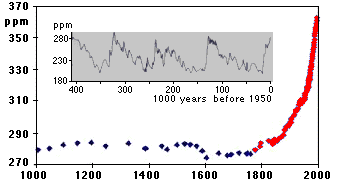
It is well known that the concentration of carbon dioxide in the atmosphere is increasing. Carbon dioxide (CO2) is a greenhouse gas, which means that it lets radiation from the Sun pass but blocks heat radiation from the Earth. Having the right amount of CO2 in the atmosphere is important because it determines how much of the Sun's warmth is used to keep the Earth at its temperature. Most scientists now agree that the increase in atmospheric CO2 is at least partly due to the burning of fossil fuels and leads to global warming, with potentially disastrous effects for climate.

Carbon dioxide concentrations (ppm = parts per million) during the past thousand years, from measurements of air trapped in Antarctic ice (blue; supplied by the Australian Antarctic Division) and, since the late 1970s, from analysis by the Cape Grim Baseline Air Pollution Station in Tasmania (red). Adapted from CSIRO Atmospheric Research (2002).
The inset gives measurements from long ice cores for the last 400,000 years. They show that CO2 concentrations varied over geological time between 190 ppm and 300 ppm. The observed increase since industrialization exceeds this natural variability by far.
The immense effort invested in climate change research since the IPCC was founded in 1988 has led to rapid advances in the scientific community's understanding of climate change and, despite increasing political pressure during the assessment process, a strengthening of the panel's conclusions:
Because of the requirements for inclusivity and consensus building, developing an assessment is a long and arduous task. For example, the Third Assessment Report was begun in 1998, completed in early 2000, and was under review for more than a year before being released in the first half of 2001.
CSIRO Atmospheric Research (2002) The greenhouse effect. Information Sheet, http://www.dar.csiro.au/publications/holper_2001b.html (accessed 12 October 2004)